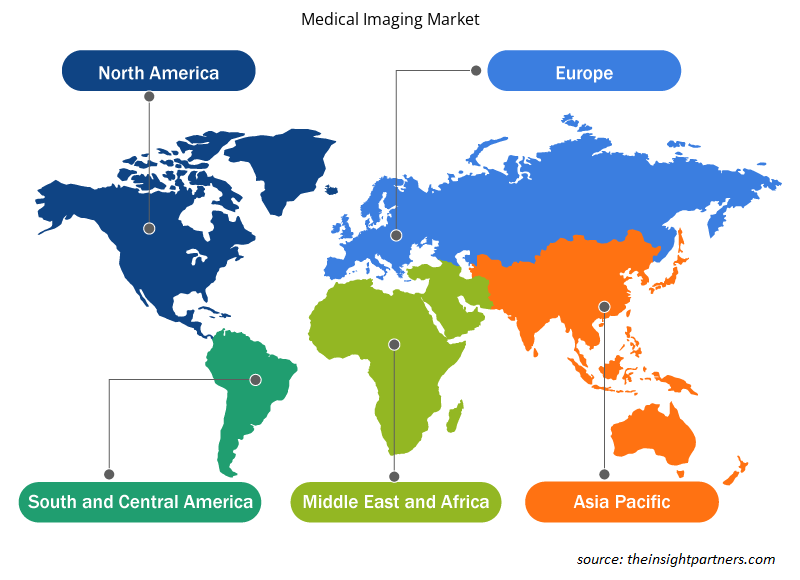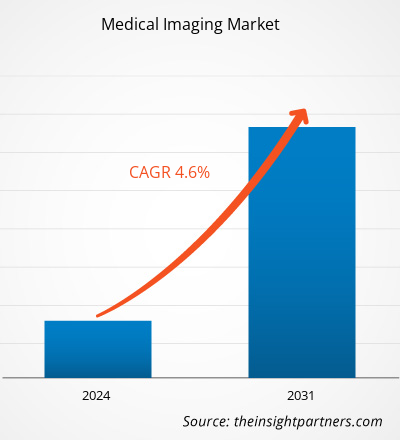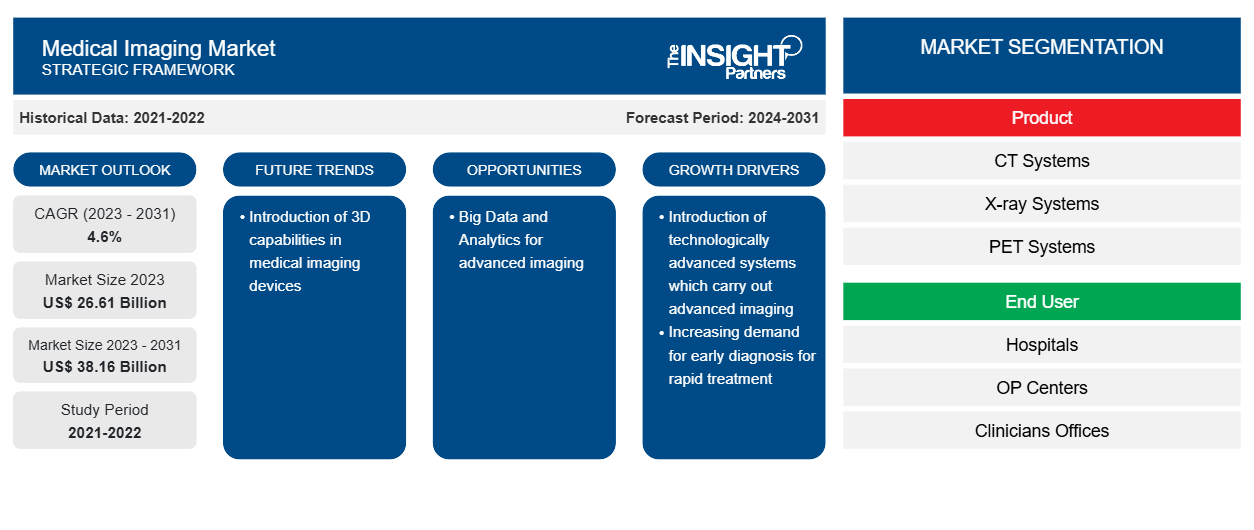预计到 2031 年,医疗成像市场规模将从 2023 年的 266.1 亿美元增至 381.6 亿美元。预计 2023-2031 年期间,市场复合年增长率将达到 4.6%。在医疗成像设备中引入 3D 功能可能仍是市场的主要趋势。
医疗成像市场分析
早期疾病诊断需求的增加和临床应用范围的扩大、老年人口的快速增长以及随之而来的相关疾病患病率的上升、诊断成像行业的技术进步以及公私组织不断增加的投资、资金和补助,这些因素都推动了医学成像市场的增长。此外,政府推动医学成像用于疾病预防的举措、对创新医学成像研发活动的投入增加以及发展中国家医学成像的日益普及,都推动了市场份额的增长。
医疗成像市场概况
从地域上看,预计亚太地区在 2023-2031 年的预测期内将实现最高的复合年增长率。市场参与者越来越关注引进针对各种疾病的先进医学成像技术,这推动了市场的增长。印度位列全球前 20 大医疗器械制造商之列,是亚洲第四大医疗器械制造商,其次是日本、中国和韩国。凭借其十多亿的人口基数、健康意识、经济繁荣、技术专长、技术人员的丰富以及医疗设施的发展,该国很可能实现潜在增长。
定制此报告以满足您的需求
您可以免费定制任何报告,包括本报告的部分内容、国家级分析、Excel 数据包,以及为初创企业和大学提供优惠和折扣
-
获取此报告的关键市场趋势。这个免费样品将包括数据分析,从市场趋势到估计和预测。
医学成像市场驱动因素和机遇
早期诊断需求增加,市场利好
诊断测试是医疗保健系统的重要组成部分,它提供重要信息,使提供者和患者能够做出正确的临床决策。大约 75% 的临床决策基于诊断测试。对更快、更准确诊断的需求以每年 10% 的速度增长,这增加了成本,并对诊断提供者的能力和能力造成压力。从患者的角度来看,早期发现和诊断可以避免不必要的疼痛和痛苦。它还可以减少治疗的规模和成本。大量研究将早期诊断与可衡量的健康益处联系起来,例如提高存活率和降低治疗成本。此外,政府的认识将进一步推动市场增长。例如,“明确癌症”运动旨在通过提高公众对癌症体征和症状的认识来加强癌症的早期诊断,并鼓励人们立即去看全科医生。英国公共卫生部负责该计划,与卫生部和英国国民医疗服务体系合作。因此,对早期诊断的需求增加正在推动医学成像市场的增长。
大数据和分析为市场增长提供机遇
根据 ITN 上的一篇文章,CitiusTech 的 Dhaval Shah 和 Prashanth Kollaikal 讨论了大数据在诊断成像中的潜力,并指出放射信息系统 (RIS) 和 PACS 系统(尤其是云中的系统)中新奇有趣的功能。文章中还提到了这些功能可能还包括分析以及有关运营和临床数据的令人印象深刻的报告。企业范围的关键绩效指标 (KPI) 来自各种来源。这些 KPI 通常用于满足提供商的需求,并考虑临床和运营效率以及患者的舒适度。尽管这些 KPI 多年来一直用于优化,但总体效率可以轻松衡量,并且可以通过设备的技术熟练程度、增加的模式、先进的软件系统和移动设备来提高。因此,对医学成像中大数据和分析的使用日益关注为医学成像市场的增长提供了机会。
医学成像市场报告细分分析
有助于得出医学成像市场分析的关键部分是产品和最终用户。
- 根据产品,医学成像市场分为 CT 系统、X 射线系统、PET 系统、MRI 系统、超声系统等。X 射线系统部分在 2023 年占据了最大的市场份额。
- 根据最终用户,医疗成像市场分为医院、外科手术中心、临床医生办公室和急救中心。医院部门在 2023 年占据了最大的市场份额。
按地区划分的医学成像市场份额分析
医学成像市场报告的地理范围主要分为五个区域:北美、亚太、欧洲、中东和非洲、南美和中美。
北美占据了市场主导地位。北美的增长特点是医院和诊所对医学成像和服务的需求增加、接受诊断成像程序的患者数量增加、患者意识高、报销情况有利以及医疗保健支出最高。此外,该地区各国老年人口增加、慢性病数量增加以及诊断和医学成像中心数量增加,可能是预测年份北美医学成像市场增长的原因。美国拥有许多先进的外科治疗诊所和越来越多的骨科手术。老年人口的增加是市场增长的因素之一。老龄人口的增加反映了接受医疗治疗的人口增加。癌症患病率的上升预计将增加美国对医学成像设备的需求。
医学成像市场区域洞察
Insight Partners 的分析师已详细解释了预测期内影响医学成像市场的区域趋势和因素。本节还讨论了北美、欧洲、亚太地区、中东和非洲以及南美和中美洲的医学成像市场细分和地理位置。

- 获取医学成像市场的区域特定数据
医学成像市场报告范围
| 报告属性 | 细节 |
|---|---|
| 2023 年的市场规模 | 266.1亿美元 |
| 2031 年市场规模 | 381.6亿美元 |
| 全球复合年增长率(2023 - 2031) | 4.6% |
| 史料 | 2021-2022 |
| 预测期 | 2024-2031 |
| 涵盖的领域 |
按产品
|
| 覆盖地区和国家 |
北美
|
| 市场领导者和主要公司简介 |
|
医学成像市场参与者密度:了解其对业务动态的影响
医疗成像市场正在快速增长,这得益于终端用户需求的不断增长,而这些需求又源于消费者偏好的不断变化、技术进步以及对产品优势的认识不断提高等因素。随着需求的增加,企业正在扩大其产品范围,进行创新以满足消费者的需求,并利用新兴趋势,从而进一步推动市场增长。
市场参与者密度是指在特定市场或行业内运营的企业或公司的分布情况。它表明在给定市场空间中,相对于其规模或总市场价值,有多少竞争对手(市场参与者)存在。
在医学成像市场运营的主要公司有:
- 通用电气公司
- 西门子股份公司
- 荷兰皇家飞利浦公司
- 岛津制作所
- 日立制作所有限公司
- 佳能公司
免责声明:上面列出的公司没有按照任何特定顺序排列。

- 获取医疗成像市场顶级关键参与者概述
医学成像市场新闻和最新发展
医学成像市场通过收集主要和次要研究后的定性和定量数据进行评估,其中包括重要的公司出版物、协会数据和数据库。以下列出了医学成像市场的一些发展:
- 富士胶片印度公司在印度放射和成像协会 (IRIA) 第 75 届全国大会上扩大了其产品和解决方案组合。Arietta 850 DeepInsight 和 Arietta 650 DeepInsight 在 IRIA 2023 上推出,是富士胶片印度公司最新推出的超声波技术产品。新成像品牌“DeepInsight”由 5 个元素组成:准确性、可重复性、可视性、效率和 AI 利用率。(来源:富士胶片,公司网站,2023 年 2 月)
- FUJIFILM Healthcare Americas Corporation 的新型 1.5 特斯拉磁共振成像 (MRI) 系统 ECHELON Synergy 已获得 FDA 510(k) 批准。该系统采用富士胶片专有的深度学习重建 (DLR) 技术 Synergy DLR,该技术由人工智能 (AI) 驱动,可增强图像清晰度并更快地获取扫描结果,从而提高吞吐量、图像质量和患者满意度。(来源:富士胶片,公司网站,2023 年 8 月)
医学成像市场报告覆盖范围和交付成果
“医学成像市场规模和预测(2021-2031)”报告对以下领域进行了详细的市场分析:
- 范围内涵盖的所有主要细分市场的全球、区域和国家/地区快速检测试剂市场规模和预测
- 快速检测试剂盒市场趋势以及市场动态,如驱动因素、限制因素和关键机遇
- 详细的 PEST/波特五力分析和 SWOT 分析
- 快速检测试剂盒市场分析涵盖主要市场趋势、全球和区域框架、主要参与者、法规和最新市场发展
- 行业格局和竞争分析,涵盖市场集中度、热图分析、知名参与者以及医学成像市场的最新发展
- 详细的公司简介
- 历史分析(2 年)、基准年、预测(7 年)及复合年增长率
- PEST和SWOT分析
- 市场规模、价值/数量 - 全球、区域、国家
- 行业和竞争格局
- Excel 数据集
近期报告
相关报告
客户评价
购买理由
- 明智的决策
- 了解市场动态
- 竞争分析
- 客户洞察
- 市场预测
- 风险规避
- 战略规划
- 投资论证
- 识别新兴市场
- 优化营销策略
- 提升运营效率
- 顺应监管趋势























 获取免费样品 - 医疗影像市场
获取免费样品 - 医疗影像市场